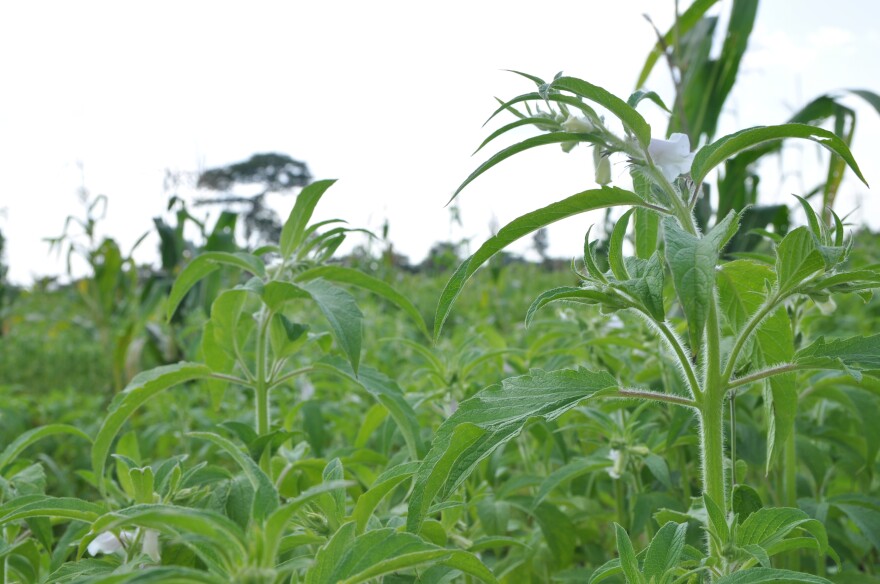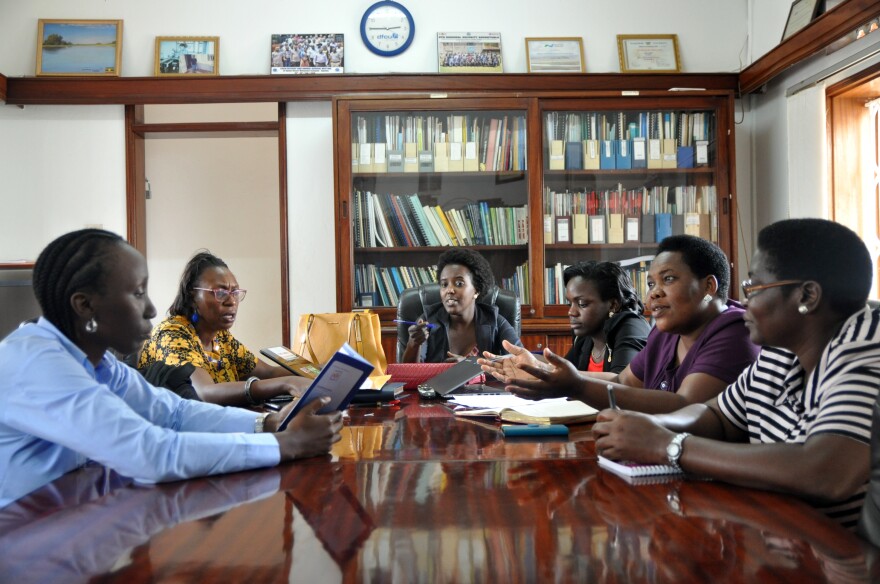NAMULONGE, Uganda — Before rows of tall, green bushes, Jude Aleu picks a cassava tuber off the ground and cracks it in half.
That shouldn’t be so easy. Healthy cassava tubers — a staple food crop in the region — can grow as thick as your upper arm. But the root in Aleu’s hands is stunted and gnarled because of a plant virus called brown streak disease. When he breaks it open, the flesh is streaked with brown and yellow, a necrosis that will render the harvest inedible.
“It’s corky,” said Aleu, a cassava safety manager for Uganda’s National Crops Resources Research Institute. “This root you cannot eat. Even animals cannot eat it.”
Aleu and his colleagues are working with scientists from the Donald Danforth Plant Science Center in Creve Coeur to test cassava plants that are genetically modified to resist disease in a project called VIRCA — Virus Resistant Cassava for Africa.

“It is a manageable disease,” Aleu said, “But I think GMOs would be the best way.”
The institute’s cassava garden is a test site where different varieties are grown to measure resistance to brown streak and other viruses. Clusters of laboratories are surrounded by lush acres of sweet potatoes, banana trees and mango groves. Throughout the campus, scientists are testing crops for traits that they hope will keep Uganda’s growing population fed as the climate continues to change.
Cassava — a thick, starchy tuber that’s grown by subsistence farmers — holds some of the most promise for this task. The tough, woody stalks can grow in hard soil and in times of drought. Some varieties can stay in the ground for three years or more, ready for harvest. The risk is its vulnerability to plant viruses like brown streak disease, which is becoming increasingly prevalent in Africa’s Great Lakes region.
VIRCA, which has received about $18 million from funders including the Monsanto Fund and the Bill and Melinda Gates Foundation since 2005, is going through confined field trials in both Uganda and Kenya. Like most African countries, Uganda does not have a law in place to allow farmers to grow GMOs. The country’s Parliament earlier this year tabled a proposal to allow genetically modified crops.
Read: St. Louis researchers develop genetically modified cassava for East African field trials

Farmers share hopes and concerns over GM cassava
With a series of methodical thunks and a loud crack that announces a giant root vegetable breaking the surface, Michael Okello and his daughter used a hoe to harvest a seven-month old cassava tuber on their farm in Amuru District, a six-hour drive north of Kampala.
Loading...
“My home is surrounded with cassava,” Okello said, as he proudly shows a group of visitors around his farm. “Cassava should not be planted very far away from home.”
A garden of cassava is like a living root cellar. Ugandans plant the rows at different times of the year, so a family can dig up the roots whenever they need to eat them. For many Ugandans in the northern districts, it’s a crop that helped them survive the 1990s and early 2000s, when many were forced to live in displacement camps during an insurgency.
Read: In Uganda, cassava is a staple in times of insecurity

When brown streak virus hits a field, farmers must uproot everything to keep it from spreading. That’s what happened to Okello’s farm, back in 2013.
“You find that the stem itself gets rotten after some six, four months,” Okello said. “We tried to contact the agricultural officers, and they also failed to do anything.”
He replanted the field with simsim, the flowering plant that grows sesame seeds in its pods. Although Okello took a financial hit, his family didn’t go hungry. He grows several crops that weren’t affected by the virus.

For poor farmers, the situation is more precarious. The Food and Agriculture Organization of the United Nations estimates that cassava viruses threaten the food security and livelihoods of 135 million people in East Africa.
But is genetic modification the best solution? Through an interpreter, Okello said that some of his neighbors have concerns.
“There’s a big fear here among farmers that the biotechnology crops that are coming might have some adverse effects on human life, some people say it causes diseases,” Okello said.
Today, he plants indigenous varieties of cassava alongside the types that are conventionally bred to be virus resistant, to improve his chances. But even these, he says, have their drawbacks.
“Most of these varieties that were brought are actually disappearing from among farmers. If this one stays for two days on the bare ground it becomes very bitter, you can even fail to eat it. That’s why we are holding on to our old varieties, to the indigenous ones,” Okello said.

Christine Anyeko, who works as a laborer in Amuru District, said she worries about brown streak virus hitting her cassava every day.
“This is my only source of livelihood, what will I do? How will I feed my children?” she said through an interpreter.
When asked about genetically modified crops, she shrugged and said she doesn’t really have an opinion. She prefers older varieties, but grows what’s available.
“Literally we don’t have other seeds. If the government brings them for us, we have nothing to do than to grow them,” Anyeko said.
To her, the more pressing matter is climate change. She sees signs of it in the field of cassava, banana and beans that she tends for her employer.
“The rain doesn’t come in time, sometimes,” Anyeko said. “And when it comes, it’s short. Sometimes you grow your crops and it fails because of a dry spell.”
Scientists push for passage of GMO bill

As it often does in late September, it was about rain, but Titus Alicai, the program leader for root crops research at Uganda’s national research institution, sat in his office with the windows open. A map of the country lit up his computer screen.
“Each dot here is an individual farmer’s field,” he said, pointing to the clusters of green, brown and red.
The color-coded points show where agriculture officials have identified cassava brown streak disease. Green dots show healthy fields. Brown shows a partial loss.
“And the red ones, are between 50 percent to 100 percent (affected). This is very high incidence of the disease,” he said, moving the computer mouse across the districts in the central region of the country.
Alicai has spent nearly 20 years studying cassava and the viruses that attack it. Brown streak virus is a tough one: The virus is transmitted by whiteflies, a common pest whose populations are booming, and the symptoms are difficult to identify before the roots are pulled up.

The National Crops Resources Research Institute has spent years trying to develop brown streak-resistant cassava using traditional breeding methods, but in Alicai’s view, it isn’t happening fast enough.
“We’ve been working for the last 12 years to develop brown streak resistant varieties. And so far what we have achieved is tolerance,” Alicai said. “Food security is being compromised. Incomes are being affected. And that has a direct effect on the economy.”
NASE-14, one of the better-performing varieties among traditionally bred cassava, loses its resistance after a year or so, Alicai said. Because cassava is planted using pieces of stalk, not seeds, that means farmers have to buy fresh cuttings instead of saving their own planting material.
Still, researchers have been working on genetically modified strains for the same length of time, and though they seem to be doing better in field trials, they won’t get through regulatory approvals until 2020 at the earliest. Alicai said that he hopes passage of a biotech bill won’t continue to stand in their way.
“For me, having this technology in my hands, seeing farmers who need this technology, I really look forward to that time when we have the law in place,” Ailcai said.

Ugandan activists hope for a stronger GMO law
On a warm afternoon in the fashionable Kampala neighborhood of Kololo, a group of women gathered around a table to launch a campaign for stricter regulation of genetically modified crops.
“Biotechnology is here, yes? But we need to understand the benefits, we need to understand the risks,” said Barbara Ntamberweki, an attorney and research officer for ACODE—the Advocates Coalition for Development and Environment.
She said Uganda will likely pass a bill to allow GMOs in the near future. But she wants to make sure that law includes regulation by an independent body, mandatory labeling and compensation for Ugandan farmers if a genetically modified crop fails or contaminates their land.
“Because when you read through the bill — the spirit of the bill, you can see that it is targeting protection of these multinational companies. There are so many clauses that are detrimental to Ugandans,” Ntamberweki said.

Ntambirweki said the Ugandan government could do a lot more to boost crop yields for poor farmers by donating tractors or improving road systems so they can get their product to market.
Though VIRCA is housed at the Danforth Center, the project does have ties to Monsanto. (The company’s pending acquisition by Bayer is not expected to affect VIRCA, according to a spokesman). The seed and chemical giant has donated millions to VIRCA, as well as the scientific procedure to insert certain genes into embryogenic cassava cells. But cassava isn’t a major cash crop — Monsanto stands to benefit more from Uganda’s adoption of genetically modified crops through the sale of maize and other seeds.
Racing the progression across Central Africa
Once confined to coastal regions, brown streak virus has spread to several countries in East and Central Africa. A solution must be found quickly, said Nigel Taylor, the VIRCA project’s principal investigator at the Danforth Center. If the virus hits Nigeria, which produces more cassava than any other nation, farmers will be in big trouble, he said.

“It’s one of numerous ways to address the problem. Because of the scale of the problem and the seriousness, it’s really important in our opinion to pursue all of the options,” Taylor said.
He’s sensitive to the controversy surrounding GMOs, both at home and abroad.
Taylor points to the fact that many of the scientists who work on VIRCA have visited or lived in St. Louis to complete training programs or PhDs.
“These plants, yes, they’ve been made here. But some of them were made by Ugandan scientists and Kenyan scientists here,” Taylor said. “They fully understand the plants being made and the goals. This, as we see, is a full partnership with our collaborators in these countries.”
This piece is part of a series reported by St. Louis Public Radio health reporter Durrie Bouscaren, who visited Uganda for a fellowship with the International Women’s Media Foundation, which is funded by the Howard G. Buffett Foundation. The HGBF is also a donor to the VIRCA project.
Follow Durrie on Twitter: @durrieB.



